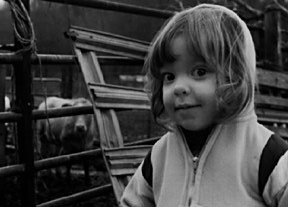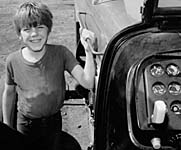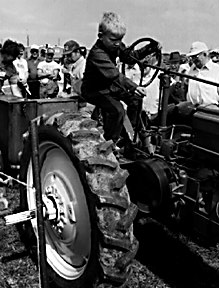Just an accident?


Five or six times a year, a child like Ashley is killed in Minnesota while playing or working on the family farm. No one even knows how many farm children like Derek or Jason* are hurt or maimed each year. These farm "accidents" happen so often that it's difficult to keep track of them.
Farm accidents involving children may seem unpredictable and random. It may seem that they can't be prevented. Some people even believe they are simply "the price of farming."
But no parent should have to sacrifice a beloved child's health just to preserve a way of life. And no farm child should have to die in "just an accident." In fact, farm accidents to children are not random. They are very predictable. And almost all of them could be prevented, according to child and farm safety experts.
Farm injuries happen when a child is doing something that is beyond his or her mental, physical or emotional ability.
A farm child's desire to do "grown-up" work may exceed his development and ability.
As they grow, all children pass through a series of developmental stages that take them from toddler to teenager. The physical changes are obvious, as a child grows taller and stronger. But along with physical changes, come changes in mental and emotional development that are sometimes harder to recognize.
For example, take a two-year-old, a toddler. Although she may be barely able to talk, a toddler is an active, engaged learner who is driven to explore her world as directly as she can. If she sees someone hide a colorful bottle in a cabinet, she will do her best to get at it, open the bottle, and taste its contents; even if she has been warned not to and even if the bottle contains poison. Preschool children can't be expected to understand cause and effect, because they're not developmentally ready to do so.
If parents of very young children understand these characteristics, they can take the right precautions, such as using "child-proof" fasteners on cabinets containing cleaning fluids or farm chemicals. Toddlers need physical barriers, such as fences, gates and locks, to keep them away from dangerous areas.
Teenagers, on the other hand, are mentally equipped to understand that risky behavior often has unpleasant consequences. But they are often driven to ignore common sense to satisfy the emotional need for experimentation that is typical of that age. A 16-year old who drives his father's pickup too fast down a county road probably knows the speed limit. He's speeding because he wants to, not because he doesn't know any better or because his legs aren't strong enough to press the brake pedal. e may also be speeding for "thrills," because there isn't enough entertainment or recreation for his age group.
Parents of teenagers must acknowledge this need for excitement and experimentation, supplying safe challenges for their maturing teens. Sports, teen activities and trips into the city can all satisfy these needs.

It's up to parents and responsible adults to keep farm kids safe.
By understanding the stages of a child's growth and development and by providing careful supervision and training that's right for each stage, parents and other adults can protect farm kids. Sound obvious? It may be. But take the three "accidents" described earlier. In each case, the child acted in a way that was consistent with his or her developmental ability, and was hurt or killed because of it.
Next is a chart that describes typical developmental stages, risks that farm kids at each stage may take, and appropriate protective measures. How well does this chart describe the youngest farmers in your household or community? Does it suggest ways that Ashley, Jason and Derek could have been protected from injury and death? Are there ways you can better protect the farm children you care about?
| Characteristics | Typical Risks | Protective Measures |
|
Toddler/Preschooler Unable to understand cause and effect Illogical, "magic" thinking Fascinated by movement or moving parts May love to climb Curious |
Drinking or eating poison Falling off farm equipment or pickup truck Drowning in pond or manure pit Wandering into highway |
Careful supervision at home or in childcare Physical barriers such as locks & fences Safe distractions Prohibiting riding on farm machinery |
|
Early School Age (5-9) Inconsistent use of logic Wishes to appear competent Wants adult approval Not aware of realistic dangers÷more fearful of kidnapping or war than of much more likely farm accident |
Livestock kicks or crushing Entanglement in augers or other moving machinery Falling out of tractor or pickup |
Consistent rules Discussion of safe behavior Assignment of simple farm chores, with careful supervision Bike safety training and use of bike helmet |
|
Older School Age (10-13) Greater physical and mental skills Physical development may outstrip mental or emotional maturity Wants social and peer acceptance Wishes to practice new skills without constant adult supervision |
Operating machinery designed for adults. Being struck by a car while riding bicycle Falling from hay loft or ladder |
Consistent rules, with consequences for infractions and
rewards for safe behavior Bike safety classes, use of bike helmet Deliberate, planned increases in chores and responsibilities Specific education on farm hazard avoidance |
|
Adolescent (13-16) Desire to experiment Strong need for peer acceptance Resistance to adult authority |
Machinery rollover or roadway accident Hearing loss from exposure to loud machinery Head or spine injury from motorcycle or ATV accident |
Education from peers who have experienced injury or illness
themselves Consistent rules, with predictable consequences for infractions and rewards for safe behavior Motorcycle and ATV safety education and use of helmets Involvement in farm safety projects through 4-H, FFA and other groups |
|
Young Adult (16-18) Increasing sense of adult responsibility and competence Desire to be supportive, take on adult share of farm work Need to take risks Feeling of "immortality" |
Same as adult risks: respiratory illness, tractor or machinery
rollover or entanglement, hearing loss, muscle or bone
injuries Additional risk from experimentation with alcohol or drugs |
Clear and consistent rules regarding drugs and alcohol
Rewards for acceptance of adult responsibilities Opportunity to be role model, teaching younger children about farm safety |
If you'd like to know more about child farm safety, contact your local extension educator, or State Extension Agricultural Safety and Health Specialist.
A related publication is University of Minnesota Extension Service Item , FO-5791 Farm Safety Day Camps
Information on the World Wide Web: Farm Safety & Health Information Clearinghouse at http://safety.cfans.umn.edu/
In accordance with the Americans with Disabilities Act, this material is available in alternative formats upon request. Please contact your Minnesota county extension office or, outside of Minnesota, contact the Distribution Center at (612) 625-8173.
The University of Minnesota Extension Service is committed to the policy that all persons shall have equal access to its programs, facilities, and employment without regard to race, color, creed, religion, national origin, sex, age, marital status, disability, public assistance status, veteran status, or sexual orientation.
The information given in this publication is for educational purposes only. Reference to commercial products or trade names is made with the understanding that no discrimination is intended and no endorsement by the University of Minnesota Extension Service is implied.
University of Minnesota Extension Service Home PageDisclaimer and Reproduction Information: Information in NASD does not represent NIOSH policy. Information included in NASD appears by permission of the author and/or copyright holder. More